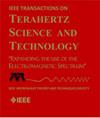WR-4.3 and WR-2.8 Band Waveguide Filters Using Micro Deformed Dual-Mode Cylindrical Resonators
IF 3.9
2区 工程技术
Q2 ENGINEERING, ELECTRICAL & ELECTRONIC
IEEE Transactions on Terahertz Science and Technology
Pub Date : 2025-01-31
DOI:10.1109/TTHZ.2025.3537467
引用次数: 0
Abstract
This letter presents two WR-4.3 and WR-2.8 band fourth order waveguide dual-mode filters, fabricated by micro metal additive manufacturing technology. For the first time, microdeformed TM110 dual-mode cylindrical resonators are employed to realize both mode coupling and frequency tuning. This structure is more compatible with additive manufacturing. One filter centered at 220 GHz has a bandwidth of 4.5% (referred to as filter A), while another one centered at 340 GHz has a bandwidth of 1.2% (referred to as filter B). To achieve tuning and coupling, a rectangular iris structure integrated with the cylindrical resonator is introduced. Compared to classical structures, such as inserting screws or using local small perturbations, the proposed design utilizes a globally distributed small deformation, minimizing abrupt features in the cavities. This approach significantly reduces sensitivity to random manufacturing errors, resulting in good agreement between theoretical and fabricated results. The best measured return loss within the passband is 19 dB for filter A and 13.5 dB for filter B, while the insertion loss is 0.5 dB for filter A and 1.7 dB for filter B. The average center frequency shift is about 0.1% of 220 GHz and 0.35% of 340 GHz, respectively.使用微变形双模圆柱谐振器的WR-4.3和WR-2.8带波导滤波器
本文介绍了采用微金属增材制造技术制备的两种WR-4.3和WR-2.8波段四阶波导双模滤波器。首次采用微变形TM110双模圆柱谐振器实现了模态耦合和频率调谐。这种结构更适合增材制造。一个以220 GHz为中心的滤波器带宽为4.5%(称为滤波器a),而另一个以340 GHz为中心的滤波器带宽为1.2%(称为滤波器B)。为了实现调谐和耦合,引入了一种与圆柱形谐振腔集成的矩形虹膜结构。与经典结构(如插入螺钉或使用局部小扰动)相比,该设计利用全局分布的小变形,最大限度地减少了空腔中的突变特征。这种方法大大降低了对随机制造误差的敏感性,从而使理论结果和实际结果很好地吻合。滤波器A和滤波器B在通带内的最佳回波损耗分别为19 dB和13.5 dB,而滤波器A和滤波器B的插入损耗分别为0.5 dB和1.7 dB,平均中心频移分别约为220 GHz和340 GHz的0.1%和0.35%。
本文章由计算机程序翻译,如有差异,请以英文原文为准。
求助全文
约1分钟内获得全文
求助全文
来源期刊

IEEE Transactions on Terahertz Science and Technology
ENGINEERING, ELECTRICAL & ELECTRONIC-OPTICS
CiteScore
7.10
自引率
9.40%
发文量
102
期刊介绍:
IEEE Transactions on Terahertz Science and Technology focuses on original research on Terahertz theory, techniques, and applications as they relate to components, devices, circuits, and systems involving the generation, transmission, and detection of Terahertz waves.
 求助内容:
求助内容: 应助结果提醒方式:
应助结果提醒方式:


